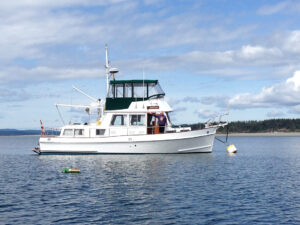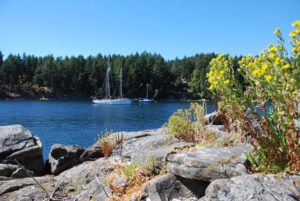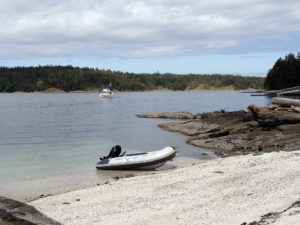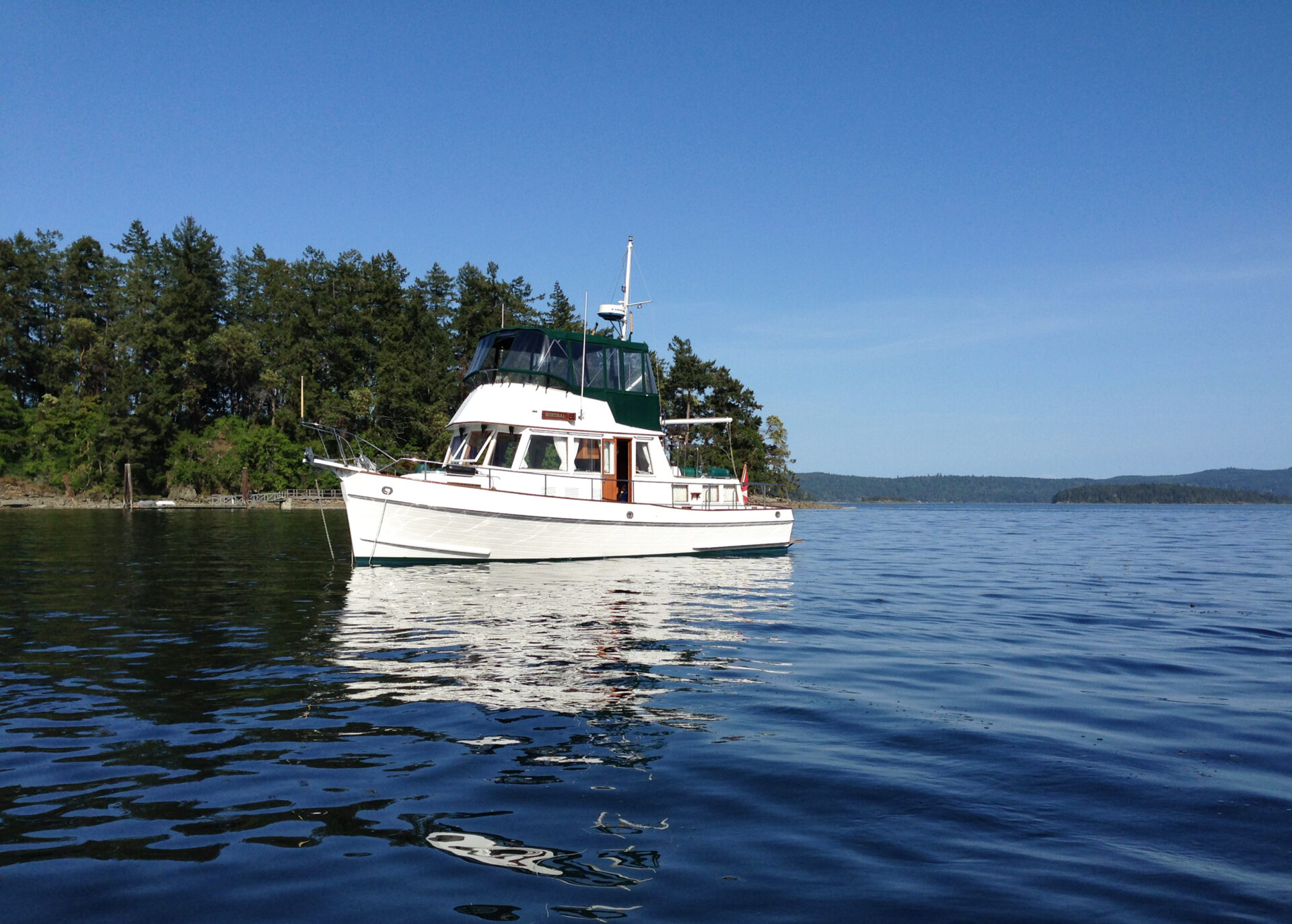Over the years, when between boats, I have occasionally chartered one for my fix of water music. On one such occasion, my friend Duart Snow, former editor of Pacific Yachting, also found himself boatless and suggested we charter a powerboat for a week of musical debates. Wisely, our wives stayed at home. After researching various companies, he found a nice Grand Banks 36 in which to tour some of our favourite haunts.
The cost of chartering a boat locally starts at around $3,500 a week for anything much over 35 feet. In addition, there is the daily insurance (optional with some companies) and taxes. Optional expenses include pre-boarding the night before the first charter day, bedding and other items such as kayaks. In our case, we arrived early with our sleeping bags and provisions to find the boat ready to go. It was very clean, with dishes, utensils and everything else needed for the trip. There was a propane barbecue and a RIB with oars and an outboard with a full tank of gas. Chartering clients should expect the boat to come stocked with the required safety equipment, a fully equipped galley, first aid kit, spare parts and tool kits. There should be an array of navigation aids such as charts, chart plotters, depth sounders and usually a few cruising guides.
One of the most pleasant aspects of chartering, apart from sampling a boating experience on a different vessel, is that once the trip is over, it’s over! No waxing, no oil changing, no nagging port leaks to worry about. It’s the company’s baby again and you can go home and plan another charter or think about something else entirely. And although the hit of a week-long charter is sobering, so is boat ownership. There’s moorage, insurance, engine and electrical maintenance, exterior and interior upkeep (teak work, gelcoat, stainless) and replacement parts. The list goes on. Adding it all up can quickly make a charter look like a good deal.

So, we plunked down our credit cards for Mistral, a Grand Banks 36 out of Sidney. The location was perfect for its proximity to our planned destinations in the southern Gulf Islands. Being close to the destination you want to explore is of course a key consideration when selecting a charter. You don’t want to spend too much time getting to the beautiful anchorages on our coast. Most companies, such as Nanaimo Yacht Charters and Desolation Sound Yacht Charters, are also near popular cruising grounds.
BEING A SAILOR for my many years of boating, I deferred to Duart’s powerboat expertise to manoeuvre the boat out of the crowded Sidney marina and into open water. He used to moor his Grand Banks 32 in the north arm of the Fraser River, a location requiring some expertise to get out of the tight marina in river current without a bow thruster. This morning, Duart easily glided the Grand Banks past the docked boats as we headed for the narrow exit. Once clear of the breakwater we headed east, bound for one of our favourite ports—Ganges Harbour.
The appeal for many boaters cruising around the Gulf Islands is the short distances between anchorages and, of course, the beautiful scenery. There are so many bays and coves with white shell beaches and overhanging arbutus it can seem almost tropical in the summer months. The waters off Sidney and Tsehum Harbour often make me think of Muriel Blanchett and her house on Curteis Point where she wrote The Curve of Time. First published in the 1960s, it remains one of the most-read books on cruising in Canada for her tales of adventure along the BC Coast. Replete with boating tips and whimsical observations, she tells of her days in the 1930s cruising in Caprice, her 26-foot (7.6-metre) wooden powerboat, with her five children. Her book encouraged the concept of small-boat cruising along our coast, a trend that exploded in popularity in the 1970s.
ABOARD MISTRAL, WE threaded our way between Goudge and Coal islands through the short John Passage, two miles from Sidney. Currents here can run up to four knots but fortunately the hazards are obvious. The drying reef at the south end of the pass has a green port beacon while the shelf farther north is marked with a red beacon. Because of these dangers, the pass is best dealt with at or near slack, which is what we did with our late-morning transit.
We continued north, keeping Brackman Island and the beaches of Portland Island to starboard. Portland Island, designated as Princess Margaret Marine Park, is a natural draw for many boaters not only for its two anchorages at either side of the island but for the miles of beautiful walks through forests and meadows.
We powered past the island to cross the two miles of Satellite Channel, leaving Beaver Point on Salt Spring Island to port, and began our approach to Ganges. It was early spring and the myriad of crab pots hadn’t arrived so the channel was relatively free of obstacles. We slowed to the required five knots and aimed for a spot adjacent to the floatplanes on the government docks. Another good place for the night is the Salt Spring Marina with Moby’s Pub at the top of the ramp—a welcome respite after several hours at the helm.
I should mention, briefly, that Ganges has more than a few attractions for boaters. The marinas are close to town, it’s a pretty harbour with lots of great dock-watching to do and, for grape aficionados, the town has three excellent wine stores with an impressive selection of imported and local wine. Years ago, during another boating adventure in the late fall, Duart and I made the mistake of lugging a full case of wine back to our boats moored half a mile away. This was after an evening at the local pub—my back hasn’t been the same since.
On this visit, we tied up to the quiet government dock close to town, tidied up the boat and as happy hour approached went up to the excellent Salt Spring Inn restaurant. Sober reflection, and the kidneys, prompted more prudent drinking this time but unfortunately the reflection part didn’t last and after a visit to a wine store, we decided to sling several bottles back to the boat. This included a few locally made favourites such as Garry Oaks Pinot Noir and Pinot Gris—both superb wines.

COFFEE IS A morning ritual for most people and making it properly is something Duart takes very seriously with a resulting brew that went very well with muffins and oatmeal cookies. After an hour lingering over breakfast, enjoying the Ganges waterfront, we set off for the next leg of our voyage—Annette Inlet on Prevost Island—five miles away.
One thing that took some getting used to for me was the delay of the GB to the helm and difficulty in maintaining a straight course, due in part to the long keel of all trawlers and the relatively small rudder. The autopilot tried to do its job, but, as I looked back at our serpentine wake, it probably didn’t appreciate my continual tweaking. I sensed it would have preferred, like Greta Garbo, to be left alone.
Less than an hour later we were inside the anchorage aiming for the lower basin where it is shallow but quiet. Annette Inlet is a long narrow anchorage, which provides good shelter but has limited swinging room in parts. It’s sometimes a good idea to take a line ashore if it has become crowded. There is a drying rock at the entrance to the inlet but you’ll avoid the hazard if you stay close to the south shore. Dead slow is how most boaters arrive.
On this visit we assumed, since it was early in the boating season, the anchorage would be empty but on arriving we found a large houseboat anchored at its south end. As we circled the vessel, a man came out to his patio who seemed friendly so we anchored 100 metres away and settled down to enjoy a pleasant day at this beautiful spot. In the warm spring air, twittering kingfishers flew overhead, a river otter scampered along a nearby shore and the large man on the houseboat climbed to his roof to sunbathe. The day was unfolding as it should. Later, at dinner, we sampled with great zeal some of our newly acquired Ganges wine.
That night, Duart and I argued music over the blaring stereo (the houseboat had his music going too) and although I won on identifying the guitars used in Midnight Rambler, Duart, employing his vault-like memory, won on obscure accompanists with Miles Davis. Somewhere along the line we decided on our next destination: Clam Bay, Thetis Island.
THE NEXT MORNING, we left Prevost Island, passing few boats on our late April cruise through the islands. When things are quiet, whether in the Gulf Islands or Haida Gwaii, when no other boats are in sight, a sense of proportion begins to assert itself. We are tiny threads in the scheme of things and perhaps what is said and done matters little, but out on the water, at least, there is some sense of scale to the surrounding tapestry. Cruising past the Gulf Islands in spring, with the trees displaying new foliage, sharpens the appreciation for this beautiful moving backdrop in all its variations of green.

After a couple of hours, we had motored north up Trincomali Channel and Houston Passage to anchor in a good spot in Clam Bay between a small island and Thetis Island. We lowered the dinghy and motored over to the little island and strolled along its midden beach. These beaches, created by First Nations people, are yet another feature of local waters we can marvel at and appreciate. When I walk on these crushed shell beaches, I often think of all the gatherings and feasting that must have taken place over hundreds of years and the many good times too, no doubt. It doesn’t seem that long ago, somehow.
Later I rowed over to a large wooden schooner anchored nearby and spoke with the owner. The vessel was based on an old Herreshoff design and looked beautiful and very sturdy. We talked until the sun began to set and I retreated to Mistral.

Later in the afternoon we were in the lee of Russell Island, an excellent marine park with a beach and good trails and often busy in the summer. With a full glass of Pinot Gris in front of me, I watched the sun disappear over Salt Spring Island. For our visit, we were the only vessel swinging on a rode and had the anchorage and the island to ourselves.
The night was quiet and our musical discourse muted as Duart and I enjoyed our penultimate night aboard Mistral. The next morning after breakfast we made our way to Sidney Spit to find this marine park also deserted, so we tied up to a buoy and went ashore in the dinghy. We walked to the old brick factory and a dock that looked over the lagoon. On the other side is a beautiful long narrow beach, the best one on the island, where Anne and I spent many summers helping to playfully bury our young sons in sand. They are grown up now, buried only in books as they finish at university, but they still remember their visits to the beaches of Sidney Spit.
LATER IN THE afternoon, we motored back to Port Sidney and the marina where the annual floating boat show was about to take place. I strolled around the marina thinking again about Muriel Blanchett and how she was right about more than her navigation insights of our coast. Time really does speed up as one ages. But for me, cruising on our coast in a boat remains one of the best ways to slow it down a bit and glimpse the tapestry as it moves irrevocably into the past.
